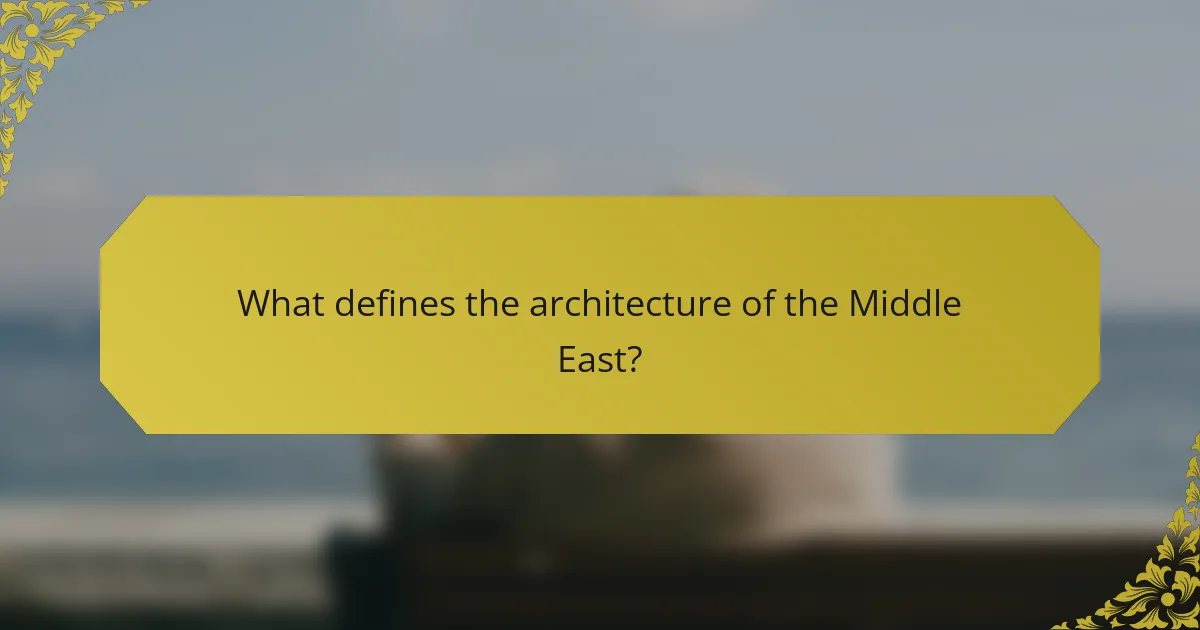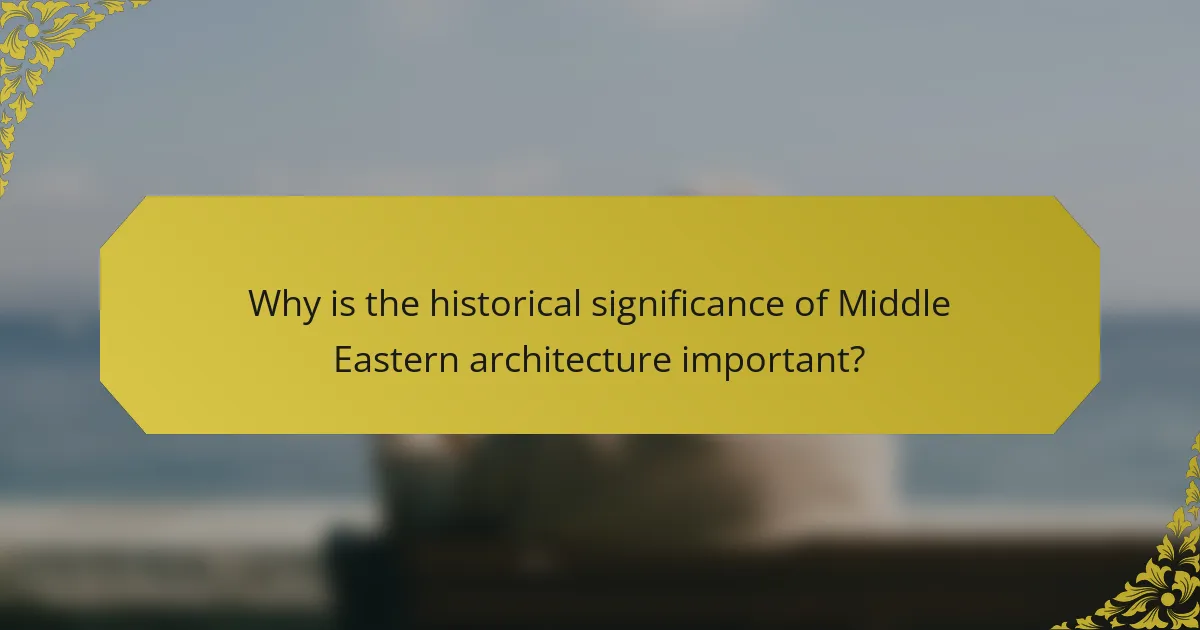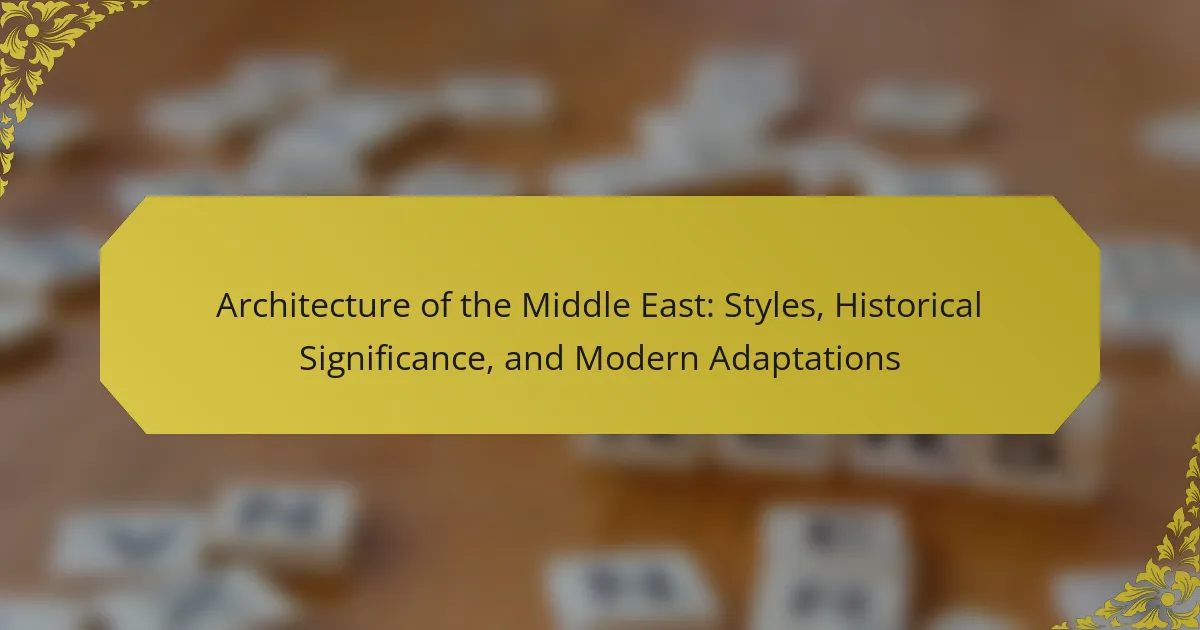
What defines the architecture of the Middle East?
The architecture of the Middle East is defined by its diverse styles and historical significance. Key elements include intricate geometric patterns and calligraphy. The use of domes and arches is prevalent in many structures. Traditional materials like stone and mud brick are commonly utilized. Islamic architecture heavily influences the region’s design. Notable examples include the Alhambra and the Great Mosque of Samarra. These structures reflect cultural and religious values. The architecture also adapts to modern needs while preserving historical context. This blend of old and new showcases the region’s architectural evolution.
How have historical events shaped Middle Eastern architectural styles?
Historical events have significantly shaped Middle Eastern architectural styles. The rise and fall of empires influenced design and construction techniques. For example, the Umayyad and Abbasid caliphates introduced intricate tile work and expansive mosque designs. The Crusades brought European Gothic elements, leading to hybrid styles in some regions. The Ottoman Empire further diversified architecture with grand palaces and public buildings. Colonialism introduced Western architectural practices, impacting urban planning and residential styles. Each historical phase contributed unique attributes, resulting in a rich tapestry of architectural diversity across the region.
What are the key historical periods influencing Middle Eastern architecture?
Key historical periods influencing Middle Eastern architecture include the ancient civilizations, Islamic Golden Age, Ottoman Empire, and modern era. The ancient civilizations, such as the Sumerians and Egyptians, established foundational architectural practices. They introduced monumental structures like temples and pyramids, influencing later designs. The Islamic Golden Age, from the 7th to the 13th centuries, saw advancements in architectural techniques and aesthetics. Notable examples include mosques with intricate geometric patterns and calligraphy. The Ottoman Empire, from the 14th to the early 20th century, contributed grand imperial architecture, exemplified by the Hagia Sophia and Topkapi Palace. The modern era has seen a blend of traditional and contemporary styles, reflecting globalization and technological advancements. Each period has left a distinct mark on the architectural landscape of the Middle East.
How did trade routes impact architectural development in the Middle East?
Trade routes significantly influenced architectural development in the Middle East. They facilitated the exchange of ideas, materials, and techniques among diverse cultures. This interaction led to the incorporation of various architectural styles. For example, the Silk Road connected East and West, introducing elements like arches and domes. Cities such as Baghdad and Damascus became melting pots of architectural innovation. The wealth generated from trade allowed for the construction of grand structures. Notable examples include mosques and palaces adorned with intricate designs. These developments reflect the cultural and economic exchanges enabled by trade routes.
What are the main architectural styles found in the Middle East?
The main architectural styles found in the Middle East include Islamic, Persian, Ottoman, and contemporary styles. Islamic architecture is characterized by features such as domes, minarets, and intricate tile work. Persian architecture often showcases grand palaces and gardens, with an emphasis on symmetry and harmony. Ottoman architecture blends elements from Byzantine and Islamic traditions, evident in its large mosques and public buildings. Contemporary styles incorporate modern materials and designs, reflecting global architectural trends while maintaining regional influences. Each of these styles has historical significance, contributing to the rich cultural heritage of the Middle East.
What are the defining characteristics of Islamic architecture?
Islamic architecture is characterized by its intricate geometric patterns, large domes, and minarets. These structures often feature expansive courtyards and gardens, reflecting a connection to nature. Calligraphy and arabesques are common decorative elements, emphasizing spiritual themes. The use of light is significant, with carefully designed windows creating a play of shadows. Islamic architecture also includes the use of iwans, which are vaulted spaces opening onto courtyards. Historical examples include the Alhambra in Spain and the Great Mosque of Samarra in Iraq. These features collectively represent the cultural and religious values of Islamic societies.
How does vernacular architecture differ across the Middle East?
Vernacular architecture in the Middle East varies significantly based on regional climate, materials, and cultural influences. In arid regions, such as parts of Saudi Arabia and the UAE, buildings often feature thick walls and small windows to minimize heat. Conversely, in mountainous areas like Lebanon, structures utilize local stone and incorporate larger windows for natural light.
Additionally, coastal regions, such as those in Oman, showcase stilted houses to combat flooding and humidity. The use of mudbrick is prevalent in traditional homes in Iraq, reflecting historical building practices.
Cultural practices also influence design; for example, courtyard layouts are common in Iranian homes, promoting social interaction while providing privacy. These architectural variations highlight the diverse environmental adaptations and cultural expressions across the Middle East.

Why is the historical significance of Middle Eastern architecture important?
The historical significance of Middle Eastern architecture is important because it reflects the region’s rich cultural heritage. This architecture showcases various styles influenced by different civilizations, including the Persians, Ottomans, and Arabs. Notable structures like the Great Mosque of Samarra and the Alhambra highlight advanced engineering and artistic expression. These buildings often served religious, political, and social purposes, shaping community identities. The architectural innovations, such as the use of arches and domes, influenced global architectural practices. Additionally, Middle Eastern architecture preserves historical narratives, providing insight into the region’s historical developments. Understanding this significance fosters appreciation for cultural diversity and historical continuity.
How does Middle Eastern architecture reflect cultural values?
Middle Eastern architecture reflects cultural values through its design, materials, and spatial organization. The use of intricate geometric patterns symbolizes the Islamic belief in the infinite nature of creation. Courtyards in homes emphasize family and community, promoting social interaction. Domes and minarets in mosques represent spiritual aspirations and connection to the divine. Traditional materials like adobe and stone showcase a harmony with the environment and local resources. Regional variations in style, such as Persian, Ottoman, and Arab, highlight the diverse cultural influences within the region. The architecture also incorporates elements of hospitality, evident in the design of guesthouses and public spaces. Overall, these architectural features embody the historical, social, and religious values of Middle Eastern cultures.
What role do religious beliefs play in architectural design?
Religious beliefs significantly influence architectural design. They dictate the form, structure, and ornamentation of buildings. For instance, mosques often feature domes and minarets, reflecting Islamic principles. Churches may have steeples and stained glass, showcasing Christian symbolism. Temples are designed to facilitate rituals and worship specific to various religions. Historical examples include the Great Mosque of Samarra, which emphasizes Islamic architecture. The Temple of Karnak in Egypt highlights ancient Egyptian religious practices. These designs serve to create sacred spaces that reflect the beliefs and values of their respective faiths.
How do traditional building materials contribute to cultural identity?
Traditional building materials significantly contribute to cultural identity by reflecting local resources and historical practices. These materials, such as mud brick, stone, and timber, are often sourced from the surrounding environment. Their use is deeply rooted in the region’s climate, geography, and cultural heritage. For example, mud brick is prevalent in arid regions due to its thermal properties and availability. Additionally, traditional techniques of construction passed down through generations foster a sense of community and belonging. The architectural styles derived from these materials often symbolize cultural values and historical narratives. In the Middle East, structures like the adobe houses of Yemen showcase unique regional characteristics. This connection between materials and identity helps preserve cultural heritage in the face of modernization.
In what ways has Middle Eastern architecture influenced global design?
Middle Eastern architecture has significantly influenced global design through its distinctive features and cultural elements. The use of intricate geometric patterns is a hallmark of Middle Eastern design. These patterns have inspired contemporary artists and architects worldwide. Additionally, the architectural style emphasizes the use of domes and arches. This has been adopted in various forms in Western architecture.
The concept of courtyard spaces is prevalent in Middle Eastern architecture. This idea has been integrated into modern urban design, promoting natural ventilation and communal areas. Moreover, the emphasis on water features, such as fountains, has influenced landscape architecture globally.
Historically, the Silk Road facilitated cultural exchange, allowing Middle Eastern architectural styles to spread. The Alhambra in Spain showcases this influence with its Islamic architectural elements. Today, many modern buildings incorporate Middle Eastern aesthetics, reflecting a blend of traditional and contemporary styles.
In summary, Middle Eastern architecture has shaped global design through geometric patterns, domes, arches, courtyards, and water features, leaving a lasting legacy on architectural practices worldwide.
What are some notable examples of Middle Eastern influence in Western architecture?
Notable examples of Middle Eastern influence in Western architecture include the Alhambra in Spain and the Great Mosque of Cordoba. The Alhambra features intricate tile work and arches, showcasing Islamic design principles. The Great Mosque of Cordoba is known for its horseshoe arches and expansive prayer hall, elements that reflect Moorish architecture. Additionally, the use of domes and minarets in buildings like the United States Capitol and the Islamic Center of America illustrates this influence. The incorporation of geometric patterns and calligraphy in Western structures also highlights the aesthetic impact of Middle Eastern styles.
How has globalization affected the preservation of traditional styles?
Globalization has significantly impacted the preservation of traditional styles in architecture. It has led to increased exposure to diverse architectural practices and materials. This exposure often results in the blending of traditional styles with modern designs. In many cases, globalization encourages the adoption of contemporary aesthetics over local heritage. Consequently, traditional architectural styles can become diluted or overlooked. However, globalization also facilitates the sharing of knowledge and techniques that can enhance preservation efforts. For instance, international collaborations can promote the restoration of historical buildings. Additionally, global tourism has sparked interest in traditional architecture, prompting some communities to preserve their cultural heritage. Overall, globalization presents both challenges and opportunities for the preservation of traditional architectural styles.

What modern adaptations are evident in Middle Eastern architecture?
Modern adaptations in Middle Eastern architecture include the integration of sustainable design practices and contemporary materials. These adaptations often feature the use of glass and steel in place of traditional stone and mud-brick. Urban developments now incorporate eco-friendly technologies like solar panels and rainwater harvesting systems. Additionally, many new buildings blend traditional motifs with modern aesthetics. This fusion is evident in structures such as the King Abdulaziz Center for World Culture in Saudi Arabia. The center showcases a modern interpretation of Arabic architectural elements. Furthermore, adaptive reuse of historical buildings is becoming common in cities like Beirut and Cairo. These adaptations reflect a balance between heritage and innovation in the region’s architectural landscape.
How are contemporary architects responding to traditional styles?
Contemporary architects are integrating traditional styles into modern designs. They often reinterpret historical elements to create innovative structures. For instance, many utilize local materials and craftsmanship. This approach respects cultural heritage while addressing modern needs. Architects like Zaha Hadid and Hassan Ragab exemplify this blend. Their works showcase traditional motifs through contemporary lenses. This method preserves identity and fosters a dialogue between past and present. The result is architecture that is both functional and culturally resonant.
What innovations are being integrated into modern Middle Eastern buildings?
Modern Middle Eastern buildings integrate smart technology, sustainable materials, and innovative designs. Smart technology includes automation systems for lighting and climate control. Sustainable materials often feature recycled components and energy-efficient insulation. Innovative designs frequently incorporate traditional elements with contemporary aesthetics. For example, the use of mashrabiya for ventilation is becoming popular again. Green roofs and solar panels are also commonly used to enhance energy efficiency. These innovations aim to address climate challenges while respecting cultural heritage. The trend reflects a growing commitment to sustainability in architecture.
How do modern adaptations address environmental concerns?
Modern adaptations in Middle Eastern architecture address environmental concerns by incorporating sustainable design principles. These adaptations often utilize local materials to reduce carbon footprints. They also emphasize energy efficiency through passive cooling and natural ventilation techniques. Green roofs and walls are increasingly integrated to enhance biodiversity and improve insulation. Water conservation systems, such as rainwater harvesting, are commonly implemented in these designs. Solar panels are frequently installed to harness renewable energy. Furthermore, modern adaptations often prioritize the preservation of existing ecosystems. These strategies collectively aim to minimize environmental impact while promoting resilience against climate change.
What challenges do modern Middle Eastern architects face?
Modern Middle Eastern architects face numerous challenges. Rapid urbanization leads to increased demand for housing and infrastructure. This often results in pressure to deliver projects quickly. Cultural heritage preservation is another significant challenge. Architects must balance modern designs with traditional aesthetics. Environmental sustainability is crucial due to harsh climates. Incorporating eco-friendly materials and energy-efficient designs is essential. Economic fluctuations can impact project funding and feasibility. Architects often navigate complex regulatory environments and bureaucratic hurdles. These challenges require innovative solutions and adaptability in design practices.
How do economic factors influence architectural projects in the region?
Economic factors significantly influence architectural projects in the region. These factors include funding availability, material costs, and labor market conditions. For instance, fluctuations in oil prices can directly impact government budgets for public infrastructure. Higher economic growth often leads to increased investment in real estate and urban development. Conversely, economic downturns can result in project delays or cancellations. The cost of construction materials can vary due to supply chain issues, affecting project feasibility. Additionally, labor costs influenced by economic conditions can dictate the scale and scope of architectural projects. Overall, economic stability fosters innovation and ambitious designs, while economic uncertainty tends to constrain architectural creativity and development.
What role does urbanization play in shaping contemporary architecture?
Urbanization significantly influences contemporary architecture by driving the need for innovative design solutions. As cities expand, architects respond to increased population density and changing lifestyles. This leads to the development of multi-functional spaces that accommodate residential, commercial, and recreational needs. Urbanization also promotes sustainable building practices due to environmental concerns. High-rise buildings and mixed-use developments have become common in urban centers. These structures maximize space while minimizing ecological footprints. The integration of technology in design is another outcome of urbanization. Smart buildings equipped with advanced systems enhance energy efficiency and user experience. Overall, urbanization shapes architecture by necessitating adaptability and sustainability in design.
What best practices should be considered for future architectural projects in the Middle East?
Sustainable design should be a primary consideration for future architectural projects in the Middle East. This involves using materials that minimize environmental impact. Incorporating energy-efficient systems is also essential. These systems can significantly reduce energy consumption. Climate-responsive design is crucial due to the region’s extreme temperatures. Utilizing natural ventilation and shading can enhance comfort. Additionally, respecting cultural heritage in design fosters community connection. Implementing smart technologies can optimize building performance. These practices align with global sustainability goals and local needs.
The main entity of the article is the architecture of the Middle East, which encompasses various styles, historical significance, and modern adaptations. The article examines the diverse architectural styles influenced by historical events, including Islamic, Persian, and Ottoman designs, highlighting key characteristics such as geometric patterns, domes, and courtyards. It also explores how trade routes and cultural exchanges have shaped architectural development, as well as the impact of globalization on the preservation of traditional styles. Additionally, the article addresses contemporary architectural practices, innovations, and the challenges faced by architects in the region, emphasizing the importance of sustainable design and cultural heritage in future projects.


